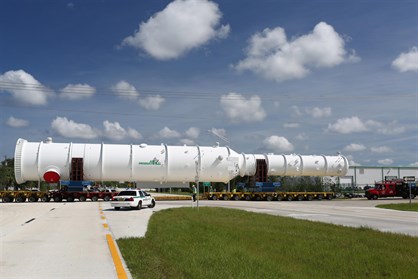Air Products completes first LNG heat exchanger unit at new Florida facility

Photo courtesy of Air Products.
Air Products completed its first LNG heat exchanger manufactured at its new production facility in Manatee County, Florida.
At the conclusion of the event, the heat exchanger was transported from the Air Products facility, crossing over Route 41 directly onto the property of Port Manatee, where it will be loaded on a barge this weekend and shipped to a customer for a major LNG project along the US Gulf Coast.
"I am proud to say that no one in the world builds coil wound heat exchangers as large as we do. The largest LNG plants in the world use our technology. We needed a second manufacturing location, which would eliminate any transportation limitations regarding product size," said Sandy McLauchlin, general manager - LNG & CryoMachinery Engineering & Manufacturing at Air Products. "When we selected this site, we believed it provided us with everything we needed in an operational location. I can tell you we made a wise choice. This new facility will help us maintain our market leadership position."
Typically, an LNG heat exchanger can be over 15 feet in diameter and 180 feet long, or about two-thirds of the size of a football field. A finished unit can weigh as much as 500 tons. "It remains to be seen how big we will build one here, but we are confident that at this new location, we can build an LNG heat exchanger to the size of whatever the market requires," McLauchlin said.
While Air Products has already shipped 116 LNG heat exchangers to 17 countries around the world, this first unit produced here at Port Manatee is also the company's first shipment to a Gulf Coast location, and is the second US location for Air Products' LNG technology, as part of responding to the needs of the LNG export industry in the US In fact, the first two units to be produced at the Port Manatee facility will travel by barge to locations on the US Gulf Coast for LNG export terminal projects.
"As the world's energy needs continue to increase, demand for cleaner energy is at the forefront, and natural gas is the cleanest of all the fossil fuels. In order to achieve the greatest economies of scale, even larger capacity LNG heat exchangers for LNG plants are being required by our customers," said Jim Solomon, director – LNG at Air Products. "Our process technology and the LNG heat exchanger are the heart of an LNG plant. Our technology operates at some of the most remote locations around the world where vast fields of natural gas are located, and it is our liquefaction process that unlocks this stranded natural resource and thus makes it economical to be shipped around the world for energy use."
One of the key draws for Air Products to locate the facility in Port Manatee was its ease of access to a port berth for shipping the proprietary and large equipment.
The Port Manatee facility doubles the company's manufacturing capacity. The over 300,000 square foot facility was dedicated in January 2014. Air Products completed the land purchase for approximately 32 acres in November 2012, after announcing plans for the manufacturing facility in July 2012.
Air Products' proprietary technology processes and cryogenically liquefies valuable natural gas for consumer and industrial use. Air Products has manufactured LNG heat exchangers at its existing Wilkes-Barre facility for over 45 years. In July 2012, the 100th coil wound heat exchanger made at the location was shipped from the facility.
In support of the LNG industry, Air Products provides process technology and key equipment for the heart of the natural gas liquefaction process for large export plants, small and mid-sized LNG plants, floating LNG plants and LNG peak shavers. Upstream, Air Products provides both nitrogen and natural gas dehydration membrane systems for offshore platforms. Downstream, Air Products provides dry inert gas generators for LNG carriers, shipboard membrane nitrogen systems, and land-based membrane and cryogenic nitrogen systems for LNG import terminals and base-load LNG plants.

- Credit Agricole says it will not fund two major LNG projects
- Aramco awards $7.7-B contracts to add 1.5 Bscfd of raw gas to Fadhili Gas Plant
- Japan's JERA suspends output at 4 gas-fired power plants to secure LNG stocks
- LNG Canada expansion to be decided by 2025
- TotalEnergies: Papua LNG project requires 'more work' to reach final investment decision
- Technip Energies awarded a major LNG contract for the North Field South Project by QatarEnergy
- Shell publishes Energy Transition Strategy 2024
- QatarEnergy to charter 19 new LNG vessels expanding fleet further
- Aramco awards $7.7-B contracts to add 1.5 Bscfd of raw gas to Fadhili Gas Plant
- Mabanaft announces successful acquisition of WESTFA Energy GmbH



Comments